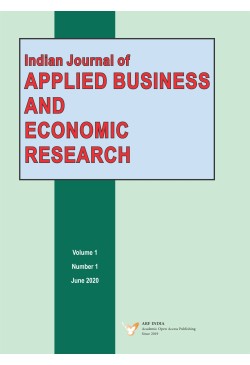
Indian Journal of Applied Business and Economic Research
Frequency :Bi-Annual
ISSN :2582-8290
Peer Reviewed Journal
BOOSTING ECONOMIC GROWTH IN ANGOLA: UNVEILING THE DYNAMICS OF DOMESTIC INVESTMENTS AND EXPORTS
Nadia Ben Yedder, Malek El Weriemmi & Sayef Bakari (2023). Boosting Economic Growth in Angola: Unveiling the Dynamics of Domestic Investments and Exports. Indian Journal of Applied Business and Economic Research. 4(2), 125-146. https://DOI:10.47509/IJABER.2023.v04i02.01
ANALYSIS OF ASSESSMENT AND ACCREDITED HIGHER EDUCATION INSTITUTIONS IN INDIA WITH SPECIAL REFERENCE TO KARNATAKA STATE
Ruchi Tripathi (2023). Analysis of Assessment and Accredited Higher Education Institutions in India with Special Reference to Karnataka State. Indian Journal of Applied Business and Economic Research. 4(2), 147-157. https://DOI:10.47509/IJABER.2023.v04i02.02
SOCIO-ECONOMIC CHARACTERISTICS OF CERTIFIED PADDY SEED PRODUCERS IN KOLHAPUR DISTRICT OF MAHARASHTRA
The socioeconomic traits of certified paddy seed producers in the Kolhapur district of Maharashtra state were the subject of the current study, which was carried out in the year 2021-22. This study explores the socio-economic characteristics of certified paddy seed farmers, analyzing data related to age, education, family size, and occupation. The average family size is 5.53 members, with 79.03% actively involved in farm work. The average age varies among small, medium, and large groups, with an overall average of 46.21 years. Education levels show diverse patterns across groups, with a significant proportion having education up to higher secondary levels. Farming is the primary occupation for 66.67% of farmers, with some engaging in subsidiary businesses or service sectors. Land utilization reveals an average landholding of 2.25 hectares, with cropping intensity increasing progressively across farm sizes. Certified paddy seed farmers cultivate an average of 2.12 hectares, with diverse cropping patterns across seasons. The study sheds light on the demographic, educational, and agricultural practices of certified paddy seed farmers, offering valuable insights for policymakers and researchers in the agricultural sector.
Gaurav Rathod, Jadhav, JB Patil, HR Shinde, Omkar Bendre, BJ Deshmukh, Pooja Harish, Shital Hange and Kuruva Parusharam (2023). Socio-Economic Characteristics of Certified Paddy Seed Producers in Kolhapur District of Maharashtra. Indian Journal of Applied Business and Economic Research. 4(2), 159-168. https://DOI:10.47509/IJABER.2023.v04i02.03
MARKETING PRACTICES, PRICE SPREAD, AND MARKETING EFFICIENCY OF GOAT MARKETING IN SATARA DISTRICT OF MAHARASHTRA
Bendre Omkar, MS Jadhav, HR Shinde, DD Patange, Sudarsan Lohar BJ Deshmukh, KJ Patil, Gaurav Rathod, Parshuram Kuruva, Shital Hange and Pooja Harish (2023). Marketing Practices, Price Spread, and Marketing Efficiency of Goat Marketing in Satara District of Maharashtra. Indian Journal of Applied Business and Economic Research. 4(2), 169-178. https://DOI:10.47509/IJABER.2023.v04i02.04
IMPACT OF MINOR IRRIGATION ON RURAL LIVELIHOODS OF ANDHRA PRADESH: A STUDY IN VIZIANAGARAM DISTRICT
THE NEXUX BETWEEN MONETARY POLICY AND SUSTAINABLE DEVELOPMENT GOALS NUMBER TEN IN NIGERIA
The lingering menace of income disparities amongst citizens in Nigeria have become rampant and a serios challenge to policy makers amidst era of continuous monetary policy crises, as well as the increasing pressure from the global community vis-a-vis the attainment of Sustainable Development Goals number ten (SDG-10). This study examines the nexus between monetary policy and sustainable development goals number ten in Nigeria from (1987 to 2022). The data for this study were collected from secondary sources which includes; World Bank and World Development Indicator online data base, previous research and government documents as well as journals articles. The estimation techniques used for this study is econometrics tools to run the regression, unit root test, ARDL, Bound Test and granger causality tests. The result of the unit root test revealed that there is combination of I(1) and I(0) among the variables, ARDL test result shows that there is existing of long relationship through the bound test, of F-statistics 5.633258 at 10 and 5 per cent respectively. The granger causality test indicates the unidirectional causality, bidirectional causality and no causality relationship among the variables. The result of the short-run and long run indicates that the monetary policy have both positive and negative impact on SDG-10 in Nigeria. What remains to be done is for the government to consider the inflationary and exchange rates in Nigeria in order to tackle the level of inequality amongst the citizens. This can be effectively carried out through a stringent price control for goods and services as well as implementing a fixed exchange rate policy that would restrict the ever-declining value of naira relative to dollar exchange rate. If effectively articulated, it will ensure equitable distribution of income and wealth amongst the citizens in the country.
Keywords: Monetary Policy, Reduced Inequality, Sustainable Development Goals, Nigeria
TAX HAVEN OR TAX EVASION: HOW DO MULTINATIONAL CORPORATIONS USE TAX HAVENS?